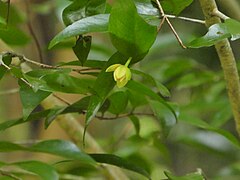Meiogyne cylindrocarpa
| Fingersop | |
|---|---|

| |
| Cairns Botanic Gardens, Jan 2023 | |
| Scientific classification | |
| Kingdom: | Plantae |
| Clade: | Tracheophytes |
| Clade: | Angiosperms |
| Clade: | Magnoliids |
| Order: | Magnoliales |
| Family: | Annonaceae |
| Genus: | Meiogyne |
| Species: | M. cylindrocarpa
|
| Binomial name | |
| Meiogyne cylindrocarpa | |
| Synonyms[4] | |
|
Homotypic
Heterotypic
| |
Meiogyne cylindrocarpa, commonly known as fingersop or native apricot in Australia, is a small tree or shrub in the custard apple family Annonaceae, native to parts of tropical Asia and Australasia.
Description[edit]
Meiogyne cylindrocarpa is an evergreen rainforest plant with an open habit. It will grow to 10 m (33 ft) high, and perhaps 20 m (66 ft).[5] The dark green leaves are held on petioles about 1.5 to 3 mm (0.06 to 0.12 in) long, and measure up to 9.6 cm (3.8 in) long by 4.3 cm (1.7 in) wide, with 7 to 13 pairs of secondary veins.[5][6] They are glossy above and glabrescent (minutely hairy) underneath.[5]
The flowers may be solitary or paired,[5] with six fleshy, triangular petals arranged in two whorls of three. The outer petals measure up to 10 mm (0.39 in) long by 7 mm (0.28 in) wide.[5]
The fruit are elongated and cylindrical in shape. They measure up to 3.3 cm (1.3 in) long and 1.6 cm (0.63 in) diameter, and are initially green, becoming orange or red when ripe, and they contain up to 9 disc-like seeds up to 9 mm diameter.[5] They are edible and sweet and have been compared to a sapodilla with a floral flavour.[7]
Taxonomy[edit]
This plant was first described in 1909 as Mitrephora cylindrocarpa by the Dutch botanist William Burck, and published in the book Nova Guinea : résultats de l'expédition scientifique néerlandaise à la Nouvelle-Guinée.[8] In 1945 it was transferred to the genus Polyaulax by another Dutch botanist, Cornelis Andries Backer,[9] where it remained until 1994 when it was again transferred to a new genus and given the current combination by E.C.H. van Heusden, also from the Netherlands.[10]
Distribution and habitat[edit]
Meiogyne cylindrocarpa is found from Vietnam southwards through Malesia to Western Australia, the Northern Territory and Queensland in Australia, and eastwards through the Philippines to the Mariana Islands. It also occurs in New Guinea and Vanuatu.[11] It grows in drier types of rainforest such as monsoon forest, in rocky areas and gullies.[5][6]
Ecology[edit]
This plant is a host plant for larvae of the pale green triangle butterfly Graphium eurypylus.[5] The fruit are eaten by fruit doves.[12]
Conservation[edit]
This species has been assessed as being of least concern by both the International Union for Conservation of Nature and by the Queensland Government under its Nature Conservation Act.[1]
Cultivation[edit]
Fingersop is typically propagated by seeds, taking anywhere from two weeks to six months to germinate. Seedlings of M. c. subsp. cylindrocarpa tend to be smaller, with a bushier form than M. c. subsp. trichocarpa, which is more erect. Trees bear fruit after five to six years, but when grafted, will produce much sooner and develop a smaller, more compact form.[citation needed]
The plant is available in Australia and elsewhere from plant nurseries.[7]
Gallery[edit]
-
Habit
-
Flower and foliage
-
Unripe fruit
-
Fruit and seeds
References[edit]
- ^ a b "Species profile—Meiogyne cylindrocarpa". Queensland Department of Environment and Science. Queensland Government. 2022. Retrieved 12 April 2023.
- ^ Botanic Gardens Conservation International (BGCI); IUCN SSC Global Tree Specialist Group. (2018). "Meiogyne cylindrocarpa". IUCN Red List of Threatened Species. 2018: e.T136089132A136089134. doi:10.2305/IUCN.UK.2018-2.RLTS.T136089132A136089134.en. Retrieved 12 April 2023.
- ^ "Meiogyne cylindrocarpa". Australian Plant Name Index (APNI). Centre for Australian National Biodiversity Research, Australian Government. Retrieved 12 April 2023.
- ^ a b "Meiogyne cylindrocarpa (Burck) Heusden". Plants of the World Online. Royal Botanic Gardens, Kew. Retrieved 12 April 2023.
- ^ a b c d e f g h Jessup, L.W.; Kodela, P.G. (2022). Kodela, P.G. (ed.). "Meiogyne cylindrocarpa". Flora of Australia. Australian Biological Resources Study, Department of Climate Change, the Environment and Water: Canberra. Retrieved 13 April 2023.
- ^ a b F.A.Zich; B.P.M.Hyland; T.Whiffen; R.A.Kerrigan (2020). "Meiogyne cylindrocarpa". Australian Tropical Rainforest Plants Edition 8 (RFK8). Centre for Australian National Biodiversity Research (CANBR), Australian Government. Retrieved 13 April 2023.
- ^ a b "Meiogyne cylindrocarpa (Native Apricot)". Territory Native Plants. Retrieved 6 February 2021.
- ^ Burck, W. (1909). "Annonaceae". In Lorentz, H.A. (ed.). Nova Guinea : résultats de l'expédition scientifique néerlandaise à la Nouvelle-Guinée (in French and Latin). Leiden: E.J. Brill. p. 433. Retrieved 18 May 2024.
{{cite book}}: CS1 maint: unrecognized language (link) - ^ Backer, C.A. (1945). "Notes on the Flora of Java, II" (PDF). Blumea. 5 (3): 490–524. Retrieved 18 May 2024.
- ^ Heusden, E.C.H. van (1994). "Revision of Meiogyne (Annonaceae)" (PDF). Blumea. 38 (2): 499. Retrieved 18 May 2024.
- ^ "Polyaulax cylindrocarpa (Burck) Heusden". Global Biodiversity Information Facility. 2024. Retrieved 18 May 2024.
- ^ Cooper, Wendy; Cooper, William T. (June 2004). Fruits of the Australian Tropical Rainforest. Clifton Hill, Victoria, Australia: Nokomis Editions. p. 23. ISBN 978-0958174213.
External links[edit]
- View a map of collections and observations of this species at the Global Biodiversity Information Facility (GBIF)
- View observations of this species on iNaturalist
- See images of this species on Flickriver.com






